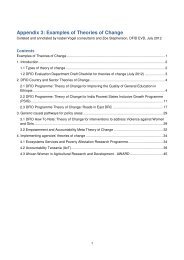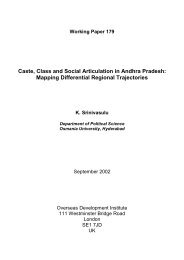Full Report - Research for Development - Department for ...
Full Report - Research for Development - Department for ...
Full Report - Research for Development - Department for ...
Create successful ePaper yourself
Turn your PDF publications into a flip-book with our unique Google optimized e-Paper software.
Executive summary<br />
Background<br />
Executive summary<br />
The burden of maternal and infant deaths falls disproportionately on low income<br />
countries (LICs) and lower middle income countries (LMCs 1 ) and among the poorest<br />
within these countries. The causes of maternal and infant mortality and morbidity<br />
are well established, yet knowledge on effective management of conditions has not<br />
been translated into significantly improved outcomes because of a lack of<br />
resources and effective models of service delivery. Urban populations are often<br />
assumed to have better access to health care than those living in rural areas.<br />
However, urban health systems in many LICs and LMCs have a weak to non-existent<br />
public health structure and lack uni<strong>for</strong>m implementation of strategies and<br />
necessary infrastructures. Given rapid urbanisation in many LICs and LMCs it is now<br />
crucial to establish evidence-based approaches to improving access to and uptake<br />
of maternal and infant care models in urban areas and improving quality of services<br />
in order to improve maternal and child outcomes. Whilst the medical solutions <strong>for</strong><br />
preventing maternal and infant mortality are known, delivering these solutions is a<br />
considerable challenge in proximity to urban slums.<br />
Objectives<br />
This systematic review addresses the question:<br />
Methods<br />
What are the effects of different models of delivery <strong>for</strong> improving<br />
maternal and infant health outcomes <strong>for</strong> poor people in urban areas in low<br />
income and lower middle income countries?’<br />
Our systematic review focused on explicit evaluations of interventions aimed at<br />
improving health outcomes <strong>for</strong> poor people in urban areas. The review focused on<br />
maternal, infant, neonatal, perinatal and post-neonatal mortality outcomes, but<br />
also included maternal and infant health outcomes. Our review team, including<br />
in<strong>for</strong>mation scientists and in<strong>for</strong>mation retrieval experts, developed a search<br />
protocol and search terms that were subject to external peer review. Our search<br />
includes major databases that cover literature on this topic; these cover both<br />
English and non-English language material, including specialist health and<br />
development databases, as well as those focusing on specific geographical areas. A<br />
comprehensive search was conducted of published and unpublished materials. The<br />
search followed the study protocol, which set out the search strategy and selection<br />
methods. The study used multiple approaches to data analysis (including:<br />
narrative; cost-effectiveness; understanding links between the cause, approaches,<br />
outcomes and sustainability of change as part of a causal chain analysis) to assess<br />
not only which interventions are effective (or not), but how and under what<br />
circumstances. Quantitative and qualitative data were collected from and coded<br />
<strong>for</strong> included items, and each item was coded <strong>for</strong> a range of variables. Interventions<br />
were grouped into clinical and non-clinical categories. We collected qualitative<br />
evidence on contextual factors and causal pathways that may help to explain why<br />
interventions were (in)effective.<br />
1 We used the World Bank classification: http://data.worldbank.org/about/country-classifications<br />
(accessed 10 March 2011).<br />
What are the effects of different models of delivery <strong>for</strong> improving maternal and infant<br />
health outcomes <strong>for</strong> poor people in urban areas in low income and lower middle income<br />
countries? 1









